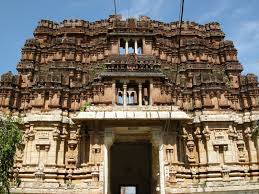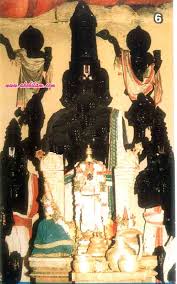1. SRIRANGAM ஸ்ரீரங்கம்:





This is the Prime Divyadesam. Sri Ranganatha is in reclining pose. Pranavakara Vimanam. Sri Tahayar is Sri Ranganayaki Thayar. Sri Chakkarattazhvar [Sudarsana] is also famous. From this Kshetram only, Swami Ramanuja revised procedures and cultivated Sri Vaishnava Sampradayam. The Lord here, first originated from Ksheerabdi and was worshiped by lord Brahma. Then the Lord was in Ayodhya and was worshiped by all the Kings of Ikshvaku dynasty. Thereafter, Vibheeshana brought the Lord here and established in this temple. He is praised by all the Ten Alwars; He has Kasturi tilak on His forehead. He is enchanting from both front and back. Srirangam is famous for festivals, for the prakarams and for Kaveri. Experience here is like in Vaikuntam.
2. WORAIYUR உறையூர் :


Here Sri Kamalavalli Nacchiyar is gracing [and so usually, in this area this place is referred to as Nacchiyar Koil]. This is near Srirangam and is called Nichulapuri. It is the birth place of Tiruppan Alwar. Lord is Sri Azhagiya Manavala Perumal. Darma Varma was the King of Chola region. In his family was born Nanda Varma Chola. He was doing many services to the Lord. Unfortunately, he had no children. He was aleays praying Lord Sri Ranganatha. Once when the King went for hunting, he found a beautiful girl child in a big lotus flower. She was none other than Sri Maha Lakshmi Thayar. The King took home that Child and named Her, Sri Kamalavalli, and brought Her up. Once Lord Sri Ranganatha saw Sri Kamalavalli, and fell in love with Her! Returning from forests, Sri Ranganatha ordered Nanda Varma to get his daughter Sri Kamalavalli, married to Him. The King obeyed and performed the marriage. Even now, during Panguni [March-April] festival, on the Sixth day, Sri Namperumal of Srirangam arrives at Woraiyur, and graces with Sri Kamalavalli Nacchiyar and it is an important event. Tirumangai Alwar has praised this Kshetram.
3. TIRU KARAMBANUR [UTTHAMAR KOIL]திருக் கரம்பனூர் [உத்தமர் கோவில்]:


In this temple all the Three Lords of Trinity are gracing. Lord here is Sri Purushottaman. Separate sannidhis are there for lord Brahma and lord Shiva. The Lord is in reclining pose. Sri Tayar is Sri Poornavalli Thayar. Kadamba tree is Sthala Vruksham. Once, the Lord appeared as a Kadamba tree and so this place got the name Tiru Kadambanur, which got transformed into Tiru Karambanur. According to legend, lord Shiva pinched off his father lord Brshma's one head. The skull stuck to lord Shiva's hand and had to wander begging to fill up the skull [so that his curse would end]. When Shiva came here, Sri Pooranavalli Thayar gave alms which filled the skull. Lord Shiva here is known as Bikshanda and so this place is also called Bikshandar Koil. Lord Brahma meditated under the Kadamba tree and got his post. Udyoga Vimanam. Tirumangai Alwar has praised the Lord here.
4. TIRU VELLARAI திரு வெள்ளறை :




This is one of the ancient Divya desam. Sri Thayar is Sri Senkamalavalli Thayar. She is also known as Sri Shenbagavalli and Sri Pankayachelvi. This place is also known as Sweta giri - Sanskrit form of Vellarai. The Lord appeared as Sri Varaha to Emperor Sibi. Once Sibi came on hunting to South. When he was chasing a white Boar, the Lord appeared as Sri Varaha to him. Swami Uyyakkondar and Swami Engal Azhvan of Sri Vaishnava sampradayam, were born here. Vimalakruti Vimanam. Lord is Sri Pundarikaksha Perumal. One might mistake Him to be Sri Namperumal. In this Kshetram, there are Seven Teerthams. Inside the temple is a teertham, with Swastika shape and is famous. Chakra teertham is also very famous. One in one bathing spot, can not see another bathing in another bathing spot. Sri Thayar meditated in the Poonkinaru and married the Lord. This Kshetram has been praised by Perialwar and Tirumangai Alwar.
5. TIRU ANBIL திரு அன்பில் :



The Lord is Sri Sundara Raja aka Sri Vadivazhagiya Nambi. The Lord is in standing pose. Sri Thayar is Sri Sundaravalli Thayar aka Sri Azhagiyavalli Thayar. Tirumazhisai Alwar has praised the Lord here. The Lord appears with enchanting beauty. Mandooka Teertham. Sage Manduka, cursed by sage Durvasa, came here and on meditation on the Lord, and got his curse cleared.
6. TIRUPPER NAGAR [KOILADI] திருப்பேர்நகர் [கோயிலடி]:




The Lord here is Sri Appakkudatthan. Tirumazhisai Alwar, Nammalwar, Periyalwar and Tirumangai Alwar have praised this Kshetram. King Subhamanyu was feeding daily 1000 persons. Once the Lord came in the guise of an Old Man, and ate away all the food prepared for 1000 persons! Surprised, the King asked the Old Man, what else He needed. The Lord asked for a pot full of Appam! Then He graced the King with the pot full of Appam; and so, He is called Sri Appakkudatthan or Sri Appalan. The Lord is gracing in reclining pose, with the Appam pot near His right hand. Sri Thayar is known as Sri Indira Devi and Sri Kamalavalli Nacchiyar. This is the last Kshetram praised by Nammalwar, before he departed for Vaikuntam.
Now we will see sloka 50 of Chapter 18:
siddhiṃ prāpto yathā brahma tathāpnoti nibodha me
samāsenaiva kaunteya niṣṭhā jñānasya yā parā 18.50
In this sloka the Lord tells about a person who had attained Naishkarmya siddhi, who later performed Bhakti yoga and reached the Lord. How does one attain Naishkarmya siddhi? In the previous sloka, the Lord told that from Gyana yoga one attains Dhyana nishtai. In this the person concentrates on atman and remains firmly. The Lord says that by performing Karma yoga, one would get Dhyana nishtai. That will lead to Atma darshan. That is understanding atman in its real form. That is, one understands that atman is ever servant of the Lord; atman is full of bliss and Gyana. With this Bhagavad Prapti or reaching the Lord is realized. This makes the person desiring to reach the Lord. Then the person performs Bhakti yoga. The Lord now advises Arjuna to learn these directions from Him. Siddhim prapti = performing Karma yoga continuously, attainment of Dhyana nishtai, yatha = by which method, brahma = [here it means] atman, apnoti = attained, tatha = that method, me = from Me [Sri Krishna], nibhoda = understand very well. Person, performing Karma yoga and having attained Naishkarmya siddhi and also attained Dhyana nishtai, is able to perceive atman and understand atman's true form. The Lord tells Arjuna that he could learn that method from Lord Sri Krishna. Arjuna is a bit baffled! He thought the sermon would end, but Sri Krishna appears to be starting again! Kaunteya = Arjuna, samasenaiva = very precisely [as no more time was available], jnanasya = the Gyana of Dhyana nishtai, para nishta = most essence [the Lord would tell]. We have to use what we have learnt. That way we can earn. Earning will maintain family and do good things. This way Bhakti would grow. Like this each activity results in starting another. The last of such activities is Para nishta or most supreme position. The Lord is going to tell how to reach that exalted position. This He is going to explain till sloka 61. Thereafter, the Lord summarizes and asks Arjuna to choose the direction.
No comments:
Post a Comment